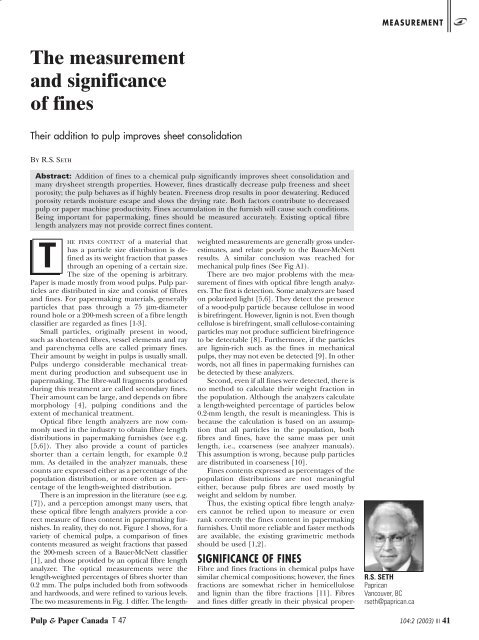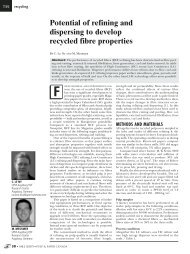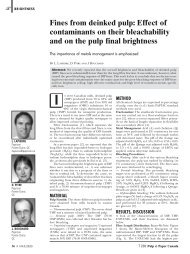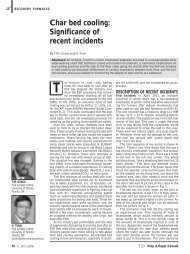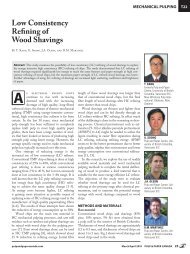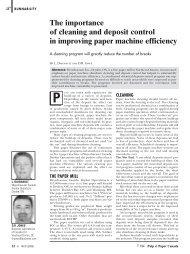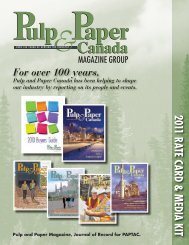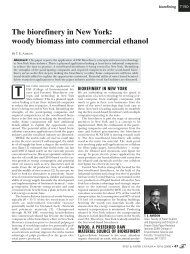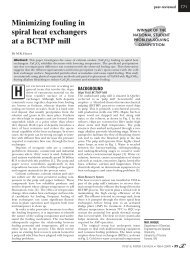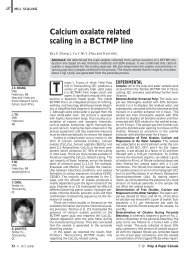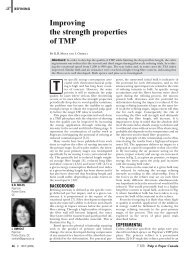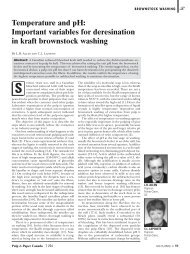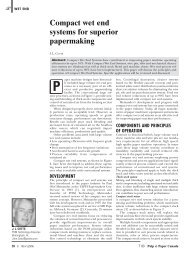The measurement and significance of fines - Pulp and Paper Canada
The measurement and significance of fines - Pulp and Paper Canada
The measurement and significance of fines - Pulp and Paper Canada
You also want an ePaper? Increase the reach of your titles
YUMPU automatically turns print PDFs into web optimized ePapers that Google loves.
MEASUREMENTFIG. 3. Cross-sections <strong>of</strong> dry sheets showing improvedsheet consolidation with increasing amount <strong>of</strong> <strong>fines</strong>. <strong>The</strong>sheets were made at 35 kPa wet-pressing pressure. <strong>The</strong>irapparent density values were: A – 0.439 g/cm 3 , B – 0.469g/cm 3 , C – 0.521 g/cm 3 . <strong>The</strong> procedure for obtaining crosssectionsis described elsewhere [22].FIG. 4. Scattering coefficient against sheet density for thepulps <strong>of</strong> Table I. <strong>The</strong> arrows in this <strong>and</strong> subsequent Figures5 to 9 indicate results obtained at 414 kPa wet-pressingpressure. <strong>The</strong> scattering coefficient was measured at 681nm.FIG. 5. Finite- <strong>and</strong> zero-span tensile strengths against sheetdensity for the pulps <strong>of</strong> Table I.FIG. 6. Elastic modulus vs. sheet density for the pulps <strong>of</strong>Table I.FIG. 7. MIT double folds vs. sheet density for the pulps <strong>of</strong>Table I.FIG. 8. Scott internal bond strength vs. sheet density forthe pulps <strong>of</strong> Table I.freeness (Table I), <strong>and</strong> the air permeability<strong>of</strong> the sheet (Fig. 9). <strong>The</strong> addition <strong>of</strong>8.2% <strong>fines</strong> to pulp A dropped its air permeabilityto one-thirtieth.To achieve an equivalent drop in thesetwo properties, the original pulp wouldhave to be beaten to about 6,000 revolutions(see Table II). In other words, as faras pulp freeness <strong>and</strong> sheet porosity are<strong>Pulp</strong> & <strong>Paper</strong> <strong>Canada</strong> T 49 104:2 (2003) ❘❘❘ 43
MEASUREMENTFIG. 9. Air permeability as a function <strong>of</strong> sheet density forthe pulps <strong>of</strong> Table I. Permeability was calculated as thereciprocal <strong>of</strong> the Gurley air resistance.FIG. A1. Comparison <strong>of</strong> <strong>fines</strong> contents <strong>of</strong> mechanical pulpsas measured by the Kajaani FS-200 fibre length analyzer<strong>and</strong> the Bauer-McNett fibre length classifier. <strong>The</strong> pulpswere made from both s<strong>of</strong>twoods <strong>and</strong> hardwoods.concerned, the pulp behaved as if highlybeaten. <strong>The</strong>se observations accord withearlier work by Tasman [13].In conclusion, the addition <strong>of</strong> <strong>fines</strong> toa chemical pulp improves sheet consolidation<strong>and</strong> many dry-sheet strength properties,<strong>and</strong> the improvements can be significant2 . However, <strong>fines</strong> drasticallydecrease pulp freeness <strong>and</strong> sheet porosity;the pulp behaves as if highly beaten. Freenessdrop results in poor dewatering. Reducedporosity retards moisture escape<strong>and</strong> slows the drying rate. Both factorscontribute to decreased pulp or papermachine productivity. Fines accumulationin the furnish will cause such conditions.ACKNOWLEDGEMENTSI thank Wayne Bichard, Susan Madey, PhilAllen, <strong>and</strong> Mel Pitz (Alberta-Pacific ForestIndustries Inc.) for contributing data toFigures 1 <strong>and</strong> A1, James Drummond forproviding sheet cross-sections in Figure 3,<strong>and</strong> Gunar Laivins <strong>and</strong> Martin MacLeodfor their valuable comments.LITERATURE1. TAPPI Test Method T 233 cm-95. Fiber length <strong>of</strong>pulp by classification.2. TAPPI Test Method T 261 cm-94. Fines fraction <strong>of</strong>paper stock by wet screening.3. TAPPI Test Method T 269 cm-92. Comprehensiveretention evaluation for paper machines.4. SETH, R.S. Beating <strong>and</strong> refining response <strong>of</strong> somereinforcement pulps. Tappi J. 82(3): 147(1999). [Errata:Tappi J. 82(4): 16 (1999). Tappi J. 82(12): 11(1999)].5. PIIRAINEN, R. Optical method provides quick <strong>and</strong>accurate analysis <strong>of</strong> fiber length. <strong>Pulp</strong> <strong>and</strong> <strong>Paper</strong>59(11): 69 (1985).6. OLSON, J.A., ROBERTSON, A.G., FINNIGAN,T.D., TURNER, R.R.H. An analyzer for fibre shape<strong>and</strong> length. JPPS 21(11): J367 (1995).7. <strong>Pulp</strong> <strong>and</strong> <strong>Paper</strong> Testing. <strong>Paper</strong>making Science <strong>and</strong>Technology. Book 17. Helsinki: FAPET, 98 (1999).8. BICHARD, W., SCUDAMORE, P. An evaluation <strong>of</strong>the comparative performance <strong>of</strong> the Kajaani FS-100<strong>and</strong> FS-200 fiber length analyzers. Tappi J. 71(12): 149(1988).9. JORDAN, B.D., O’NEILL, M.A. <strong>The</strong> birefringence<strong>of</strong> s<strong>of</strong>twood mechanical pulp <strong>fines</strong>. JPPS 20(6): J 172(1994).10. SETH, R.S., JANG, H.F., CHAN, B.K., WU, C.B.Transverse dimensions <strong>of</strong> wood pulp fibres <strong>and</strong> theirimplications for end use. In Trans., 11th Fund. Res.Symp., Cambridge, Pira International, Leatherhead,UK, 473-503 (Sept. 1997).11. HTUN, M., DE RUVO, A. <strong>The</strong> implications <strong>of</strong> theRésumé: L’ajout de <strong>fines</strong> à une pâte chimique permet d’améliorer considérablement la consolidationde la feuille et un bon nombre de caractéristiques de résistance de la feuille sèche.Toutefois, les <strong>fines</strong> réduisent radicalement l’égouttage de la pâte et la porosité de la feuille; la pâtese comporte comme si elle était très raffinée. La baisse de l’égouttage entraîne un mauvais essorage.Une faible porosité retient l’humidité dans la feuille et ralentit la vitesse de séchage. Ces deuxfacteurs contribuent à réduire la productivité de la pâte ou de la machine à papier. Une accumulationde <strong>fines</strong> dans la composition de fabrication entraînera de telles situations. Les fibres sontimportantes dans la fabrication du papier et elles doivent être mesurées avec précision. Les analyseursoptiques de la longueur des fibres actuels peuvent ne pas indiquer la teneur en <strong>fines</strong>appropriée.Reference: SETH, R.S. <strong>The</strong> <strong>measurement</strong> <strong>and</strong> <strong>significance</strong> <strong>of</strong> <strong>fines</strong>. <strong>Pulp</strong> & <strong>Paper</strong> <strong>Canada</strong>104(2): T47-T50 (February 2003). <strong>Paper</strong> presented at the 88th Annual Meeting in Montreal, QC,on January 28 to 31, 2002. Not to be reproduced without permission <strong>of</strong> PAPTAC. Manuscriptreceived September 7, 2001. Revised manuscript approved for publication by the Review Panel July10, 2002.Keywords: CHEMICAL PULPS, FINES, MEASUREMENT, PULP PROPERTIES, PRODUC-TIVITY.<strong>fines</strong> fraction for the properties <strong>of</strong> bleached kraftsheet. Svensk Papperstidn. 81 (16): 507 (1978).12. LAIVINS, G.V., SCALLAN, A.M. <strong>The</strong> influence <strong>of</strong>drying <strong>and</strong> beating on the swelling <strong>of</strong> <strong>fines</strong>. JPPS 22(5): J178 (1996).13. TASMAN, J.E. <strong>The</strong> mechanical modification <strong>of</strong>papermaking fibres. <strong>Pulp</strong> <strong>and</strong> <strong>Paper</strong> Magazine <strong>of</strong> <strong>Canada</strong>67(12): T553 (December 1966).14. LOBBEN, T.H. Effect <strong>of</strong> <strong>fines</strong> on the strengthproperties <strong>of</strong> chemical pulps. Norsk Skogindustri 31(4):93(1977).15. LOBBEN, T.H. On the influence <strong>of</strong> the pulp componentson the shrinkage <strong>and</strong> elongation <strong>of</strong> paper.Norsk Skogindustri 32(4): 80(1978).16. MOLINA MANCEBO, R., KRKOSKA, P., BLAZEJ,A. <strong>The</strong> concept, properties <strong>and</strong> papermaking role <strong>of</strong><strong>fines</strong>. Papir a Celuloza 36 (11): V75 (1981).17. Carton Board — Pr<strong>of</strong>itable use <strong>of</strong> pulps <strong>and</strong> processes.Stockholm: Swedish Forest Products ResearchLaboratory, 77 (1983).18. PRZYBYSZ, K., CZECHOWSKI, J. <strong>The</strong> effect <strong>of</strong>pulp <strong>fines</strong> on the drying process <strong>and</strong> paper strengthproperties. Cellulose Chemistry <strong>and</strong> Technology 19 (2):197 (1985).19. PAAVILAINEN, L. Importance <strong>of</strong> particle size —fibre length <strong>and</strong> <strong>fines</strong> — for the characterization <strong>of</strong>s<strong>of</strong>twood kraft pulp. <strong>Paper</strong>i ja Puu 72(5): 516 (1990).20. RETULAINEN, E., MOSS, P., NIEMINEN, K.Effect <strong>of</strong> <strong>fines</strong> on the properties <strong>of</strong> fibre networks. InTrans. 10th Fund. Res. Symp., Oxford, Pira International,Leatherhead, UK, 727-769 (Sept. 1993).21. FERREIRA, P.J., MARTINS, A.A., FIGUEIREDO,M.M. Primary <strong>and</strong> secondary <strong>fines</strong> from Eucalyptusglobulus kraft pulps. Characterization <strong>and</strong> influence.<strong>Paper</strong>i ja Puu 82 (6): 403 (2000).22. WILLIAMS, G.J., DRUMMOND, J.G. Preparation<strong>of</strong> large sections for the microscopical study <strong>of</strong> paperstructure. JPPS 26(5): J188 (2000).23. CHANG, H., SINKEY, J.D., YAN, J.F. Chemicalanalysis <strong>of</strong> refiner pulps. Tappi J. 62(9): 103 (1979).24. SETH, R.S. Zero-span tensile strength <strong>of</strong> papermakingfibres. <strong>Paper</strong>i ja Puu 83(8): 597 (2001).END NOTES1. Mechanical pulp <strong>fines</strong>, however, behavedifferently. Being lignin-rich [23], theyare relatively much stiffer. <strong>The</strong>y do notbond that well to fibres, <strong>and</strong> do not losetheir free surface as much. <strong>The</strong>refore,they contribute greatly to light scattering.2. <strong>The</strong> changes in strength properties with<strong>fines</strong> addition can be relatively small if thepulp is already beaten for high sheet consolidation[13-15].44 ❘❘❘ 104:2 (2003) T 50 <strong>Pulp</strong> & <strong>Paper</strong> <strong>Canada</strong>


